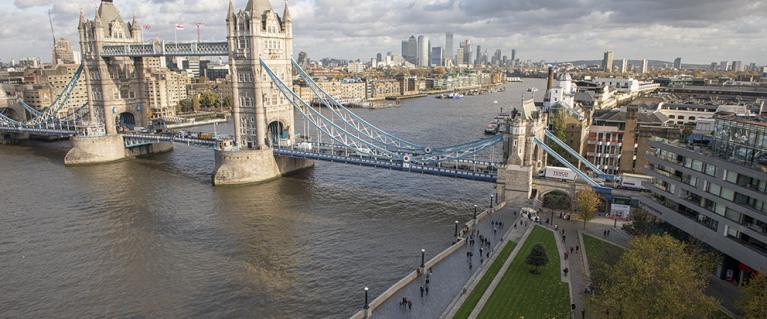
The bigger picture
As the Opening of Parliament approaches, London’s political leaders are eagerly anticipating the King’s Speech and what it will mean for the nation and their local constituents.
The LSDC calls on London’s MPs, Council Leaders and Assembly Members to advocate for climate change to remain a top priority within their respective parties – not only to avert disastrous impacts at home and internationally, but to also help communities and the economy flourish in the capital and the UK.
We need bold and unwavering leadership from national government, allied to a framework unleashing local leaders to take climate action. This must include governance with clear responsibilities for shared action, backed by long-term investment and policy certainty. And we call on local leaders to deliver that action decisively to achieve a net-zero and climate-resilient city.
This call builds on the LSDC’s recent recommendation to unlock cities including London to take rapid, fair and community-focused action on climate change. We also endorse similar calls by net-zero tsar Chris Skidmore MP’s ‘The Future is Local’ report, and the letter sent on 19th October by the Local Government Association, London Councils and others, to the Secretary of State for Energy and Net Zero, Claire Coutinho MP. They too have urged the government to support councils to accelerate local climate action, where it can be planned and delivered most effectively and cost-efficiently, and where cities are already leading the way.
The public wants decisive climate leadership: polling shows that 89% of Londoners want to prevent climate change, while only 2% don’t believe in it. And indeed, given the enormous co-benefits of climate action for communities and the economy, who would vote against warmer homes, cleaner streets, healthier children, new jobs, greener neighbourhoods, and secure energy? This gives elected representatives an unequivocal mandate to take action.
The Climate Change Committee warned in July that its “confidence in the UK meeting its medium-term targets has decreased in the past year”. Yet the government’s September U-turn on climate policies was a hammer-blow to achieving our national climate targets, while staining the UK’s reputation as a global climate leader.
The cost of climate inaction is far higher than the costs of action: and the UK Treasury, the Climate Change Committee and the Office for Budgetary Responsibility have all warned that the longer we delay, the higher the costs. New delays and broken pledges also create confusion and uncertainty for businesses, damaging investor confidence and weakening investment by making it riskier and more costly.
The UK stands at a crossroads in its economic future. The fossil fuel economy is the economy of the 19th century not the 21st. We can decide to reap the benefits of pioneering a clean, productive and resource-efficient economy, helping clean-tech innovation to flourish and locking in investment. Or we can choose to squander our leadership and get left behind the US, EU, China and others just as the global race to invest in renewable energy and green solutions is gathering pace.
London has already taken huge steps towards a more sustainable future. Sales from London’s low-carbon industries doubled from £20.9bn to £42.9bn between 2007/08 and 2020/21, and the sector employs a quarter of a million workers. It is where Octopus Energy and thousands of other innovative climate tech businesses have been founded and grown jobs in the UK and established themselves globally. The capital has cut its carbon emissions by 38% since 1990, has enhanced green spaces and transport, and cultivated its role as a global green finance hub.
Far more remains to be done to deliver local action that matches the scale of the challenge ahead. London will be on the world stage at COP 28. We trust that you will play your part in helping London and the UK to rise to this challenge, by supporting decisive and fair local climate action that enables our communities to thrive.
Yours sincerely,
Dr Ashok Sinha
Chair of the London Sustainable Development Commission

By Dimitri Zenghelis, Project Leader on the Wealth Economy Project, Cambridge University and commissioner on the London Sustainable Development Commission
January 2020
Low carbon, resource-efficient cities have more productive assets
Diverse resilient assets reinforce each other
Investment in assets drives sustainable growth

By Michele Pittini, Senior Economist, GLA Economics
January 2020
Dimitri is right to emphasise the importance of all components of London’s wealth - human, social and natural capital as well as physical assets. The notion of sustainability – in economics terms - can ultimately be connected to preserving the integrity of an aggregate stock of capital to underpin future growth in prosperity and wellbeing. As Dimitri and the Cambridge Initiative “Beyond GDP” argue, the realisation of the importance of these assets calls for better ways to measure and value them, so that they can be managed better through more informed policy decisions.
Various initiatives by international organisations in recent years (from UNEP to the World Bank and the OECD) have made this case while trying to improve the way in which economies account for all aspects of their wealth. Domestically the Office for National Statistics has published, for several years, estimates of the UK’s human capital (currently under review) and has developed indicators of social capital. Furthermore, it is working in partnership with Defra to develop natural capital accounts for the UK, with encouragement and support from the Natural Capital Committee.
Within its role and capacity, the Greater London Authority (GLA) has also made significant contributions to the way in which we measure different forms of capital and think about them in policy development.
The Natural Capital Account for London was a ground breaking study published in November 2017 that showed for the first time the economic value of health benefits that Londoners get from the capital's public parks and green spaces. This found that London’s public parks have a gross asset value in excess of £91 billion when considering general amenity, benefit to health and opportunity for exercise, and the value of recreation.
The Survey of Londoners, which was published in 2019, explored aspects of social integration (such as participation and relationship) which are often identified as key dimensions of social capital. Survey results showed that Londoners who interact with their neighbours (i.e. building local social capital) are more likely to feel they belong to London and to agree that London is a fair city, controlling for demographic and other factors. And building social capital has measurable wellbeing effects - Londoners who borrow things and exchange favours with their neighbours are 11 percentage points more likely to have high wellbeing than those who don’t, while Londoners who participate in formal cultural events are 13 percentage points less likely to be socially isolated.
And the Preliminary Resilience Assessment for the London Resilience Strategy has highlighted how by improving all the infrastructure that Londoners rely upon (“from green spaces, biodiversity and clean air to connectivity, transport, buildings and institutions around them; from water and pipelines in the ground to air transport above”) we can make the whole city more resilient.
The task quantifying the valuable but hitherto under-quantified aspects of our economy of society and environment is happening in arenas beyond economics and national accounting. A wide variety of fields under the umbrella term ‘urban analytics’ has been applied to try to model asset values and interactions dynamically – for instance, what would be the economic, societal and financial implications if we either choose to invest or disregard them? These potential applications of urban analytics were discussed (among others) at a recent conference promoted by the GLA’s City Intelligence Unit.
But the need for new, complementary indicators of social progress does not end there. There are more socio-economic statistics that matter to an administration whose stated aims include ensuring London’s continued economic success alongside the ability of all Londoners to benefit from it. Therefore at the Mayor’s request the GLA has developed Economic Fairness measures for London – a dataset that allows us to measure how fair and inclusive London’s economy is through a number of indicators grouped under three themes: a labour market that works for everyone, equal opportunities and raising living standards. These include data on ethnicity as well as disability and gender pay gaps and highlight many dimensions of inequality of outcomes and opportunity in London, including stark inequality in the income distribution (the richest ten per cent have at least 9.7 times the income of the lowest income households). While the economic fairness measures are not performance indicators for Mayoral policies (as they are driven by government policies as well as broader economic trends), policies such as the London Living Wage and the Good Work Standards aim to contribute to address some of the issues that the measures highlight.
Speaking for the economic intelligence and advisory team at City Hall I feel however that I need to add an important caveat to this discussion. From our perspective these innovative measurement efforts should aim to complement rather than replace more conventional metrics of economic performance. Despite their limitations and potential for improvement, income metrics such as GDP/GVA remain key indicators of the health of any national and local economy, being strongly correlated with employment (a key enabler of prosperity and wellbeing). As summary indicators they have useful property (not least the fact that they avoid double counting). And as part of the structured system of national accounts and economics statistics, they also enable the analysis and monitoring of a large number of economic phenomena, from productivity (GVA per hour worked) to the pace of decoupling between economic growth and emissions or material consumption.
So at the same time as the ONS seeks to push the boundaries of experimental statistics it is also essential for us that the ONS continues its valuable efforts to improve and expand their regional economic statistics (e.g. through the first ever quarterly estimates of regional GDP).
Disclaimer
The ideas, views and opinions in these blogs are those of the individuals concerned, belong solely to the authors and do not reflect in any way the views, opinions or actions of the Greater London Authority or its associated delivery bodies.
Need a document on this page in an accessible format?
If you use assistive technology (such as a screen reader) and need a version of a PDF or other document on this page in a more accessible format, please get in touch via our online form and tell us which format you need.
It will also help us if you tell us which assistive technology you use. We’ll consider your request and get back to you in 5 working days.